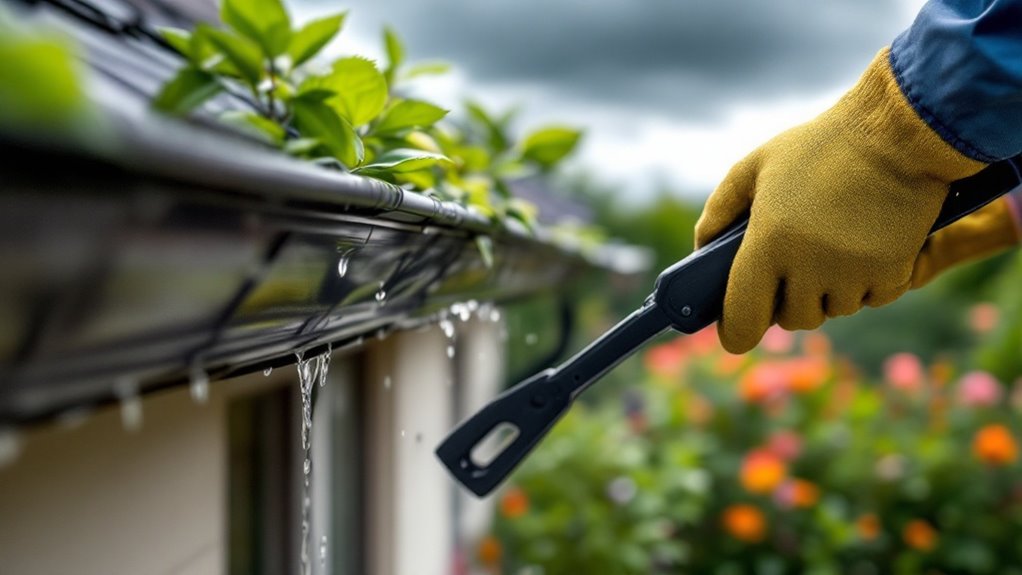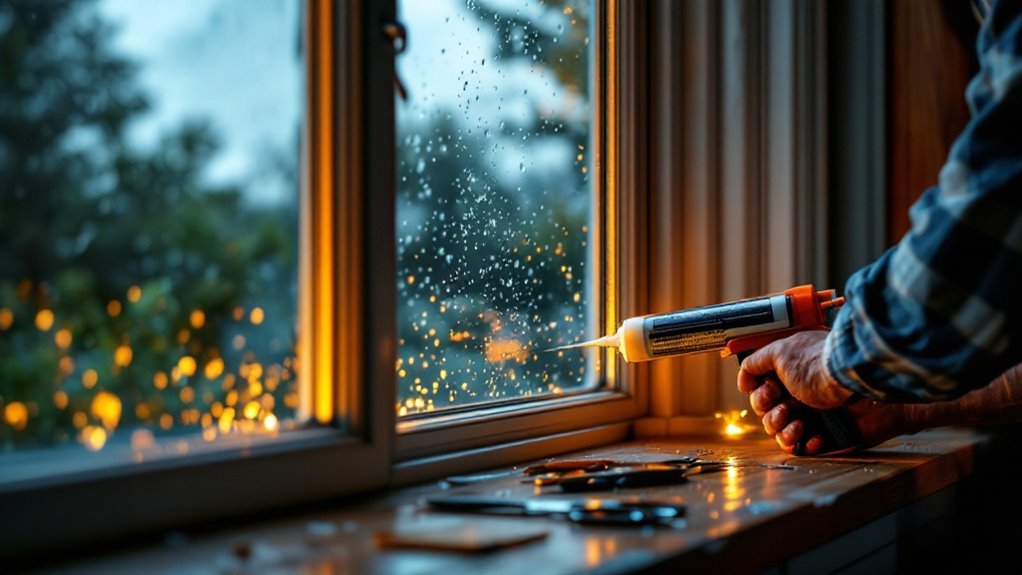Imagine dark clouds rolling in, heavy rain pouring down, and water creeping dangerously close to your doorstep. Preparing your home for such a scenario is vital to prevent costly flood damage. By taking simple yet effective steps now, you can protect your space and guarantee your family’s safety. Let’s investigate what actions you can take to safeguard your home against the elements.
Key Takeaways
- Regularly inspect and clean gutters and downspouts to prevent clogs and ensure proper water flow away from your foundation.
- Seal windows and doors with weatherstripping and caulk to prevent water infiltration during heavy rain.
- Elevate electrical systems and appliances above potential flood levels to reduce the risk of damage and electrical shock.
- Maintain drainage systems by clearing storm drains and considering a sump pump for effective water management in basements.
- Assemble a flood emergency kit with essential supplies like water, non-perishable food, and a first aid kit for quick access during emergencies.
Inspect Your Gutters and Downspouts

Before heavy rains hit, it’s crucial to inspect your gutters and downspouts to confirm they’re clear of debris. Clogged gutters can’t effectively channel water away from your home, leading to potential damage. Start by climbing a sturdy ladder, or use a scoop to remove leaves, twigs, and dirt. Don’t forget to check for any signs of rust or damage in the gutters themselves. Once you’ve cleared the debris, run water through the system to verify it flows freely. Pay particular attention to downspouts; they should direct water at least three to four feet away from your foundation. By taking these steps, you’ll help prevent water buildup that could lead to costly repairs down the line. Additionally, annual plumbing inspections can help identify potential plumbing issues early and further protect your home from flooding.
Maintain Your Drainage Systems
To keep your home safe during heavy rain, you need to maintain your drainage systems. Regularly cleaning your gutters and inspecting storm drains can prevent clogs and flooding. Don’t wait for the storm to hit—take action now to protect your property. Additionally, consider installing a sump pump to effectively manage excess water in the basement and reduce the risk of flooding.
Clean Gutters Regularly
Cleaning your gutters regularly is essential for maintaining your home’s drainage system, especially as heavy rain approaches. Clogged gutters can lead to overflow, causing water to seep into your foundation and basement. To keep your gutters in top shape, follow these simple tips:
| Task | Frequency |
|---|---|
| Remove leaves and debris | Monthly |
| Check downspouts | Monthly |
| Flush with water | After heavy rain |
| Inspect for damage | Seasonally |
Additionally, understanding your home’s specific vulnerabilities can help tailor your maintenance efforts to prevent water damage effectively.
Inspect Storm Drains
While keeping your gutters clean is an essential step, inspecting storm drains is just as significant for effective drainage during heavy rain. Make it a habit to check your storm drains regularly, especially before heavy rainfall. Look for debris, leaves, or mud that could block the flow of water. If you spot any clogs, clear them immediately to guarantee proper drainage. It’s likewise wise to check for cracks or damage in the drain itself, as these can lead to further issues. If you find significant problems, don’t hesitate to call a professional. By maintaining your storm drains, you’ll help protect your home from potential flooding and water damage when the skies open up.
Seal Windows and Doors

To keep your home dry during heavy rain, you need to seal your windows and doors effectively. Start by inspecting the weatherstripping for any damage, and replace it if necessary. Don’t forget to apply caulk where gaps appear and consider adding door sweeps for extra protection.
Inspect Weatherstripping Integrity
Before the heavy rains hit, it’s vital to inspect the integrity of your weatherstripping around windows and doors. Start by checking for any gaps, tears, or signs of wear. If you notice any damaged areas, it’s important to address them immediately, as these issues can allow water to seep into your home. Gently press on the weatherstripping to guarantee it creates a tight seal when your windows and doors are closed. Don’t forget to pay attention to the corners, where wear is often most pronounced. A quick inspection can save you from costly water damage down the line. By taking the time to verify your weatherstripping is in good condition, you’ll help keep your home dry and protected during heavy rains.
Apply Caulk as Needed
One effective way to prevent water intrusion during heavy rains is to apply caulk to seal any gaps around your windows and doors. Start by inspecting the areas for cracks or gaps that could allow water to seep in. Clean the surfaces thoroughly to guarantee proper adhesion. Choose a high-quality, waterproof caulk suitable for exterior use. Use a caulking gun to apply an even bead, filling any voids completely. Smooth the caulk with your finger or a caulking tool for a neat finish. Allow it to cure according to the manufacturer’s instructions. By sealing these vulnerable spots, you’ll reduce the risk of water damage and keep your home safe and dry during heavy downpours.
Use Door Sweeps
Sealing gaps around windows and doors helps keep your home dry, but you shouldn’t overlook using door sweeps. These simple strips of material attach to the bottom of your doors, blocking rainwater and wind from sneaking inside. Installing door sweeps is an easy DIY project. Just measure the width of your door, cut the sweep to size, and secure it in place with screws or adhesive.
Make sure the sweep aligns snugly with the floor to create a tight seal. Regularly check for wear and replace them as needed, especially before heavy rain seasons. By adding door sweeps, you’ll improve your home’s defense against flooding, ensuring a drier, more comfortable living space. Don’t wait—protect your home today!
Elevate Electrical Systems and Appliances

As heavy rain can lead to flooding, raising your electrical systems and appliances is essential for preventing costly damage and ensuring safety. Start by identifying the most vulnerable areas in your home, like basements or low-lying rooms. Move appliances such as washers, dryers, and HVAC units to higher ground or install them on platforms. Consider raising your electrical panel, outlets, and wiring above potential flood levels. This not only protects your devices but likewise reduces the risk of electrical shock. If you’re unsure how to raise these systems properly, consult a qualified electrician. Taking these steps now can save you significant stress and expenses later, allowing you to focus on enjoying your home, come rain or shine.
Create a Flood Emergency Kit
Preparing your home for heavy rain as well means being ready for emergencies that may arise from flooding. One crucial step is to create a flood emergency kit. Start by gathering items like water, non-perishable food, and a flashlight with extra batteries. Don’t forget a first aid kit, personal medications, and important documents stored in a waterproof container. Include clothing, sturdy shoes, and blankets for comfort. A multi-tool can be invaluable, as can a portable phone charger. Make sure to have a whistle to signal for help, too. Finally, keep your emergency kit in an easily accessible location, so you can grab it quickly if needed. Being prepared now can make all the difference when disaster strikes.
Develop a Flood Response Plan
To effectively manage the risks associated with heavy rain, you need to develop a flood response plan tailored to your home and family. Start by identifying evacuation routes and safe locations for shelter. Make sure everyone knows the plan and practices it regularly.
Consider these key components for your flood response plan:
- Communication: Establish how your family will stay in touch during a flood, including backup methods if phone lines fail.
- Emergency Contacts: Compile a list of important contacts, such as local emergency services and relatives.
- Safety Procedures: Outline steps to take before, during, and after flooding, including securing valuables and knowing when to evacuate.
Conclusion
As dark clouds gather and raindrops begin to sway on your roof, you’ll feel a sense of relief knowing you’ve taken steps to protect your home. Picture your gutters flowing freely, guiding the water away, while your family stays safe and dry inside. With your emergency kit ready and a solid plan in place, you’re not just weathering the storm; you’re embracing it. Stay prepared, and let the rain be a reminder of your home’s resilience against nature’s fury.
